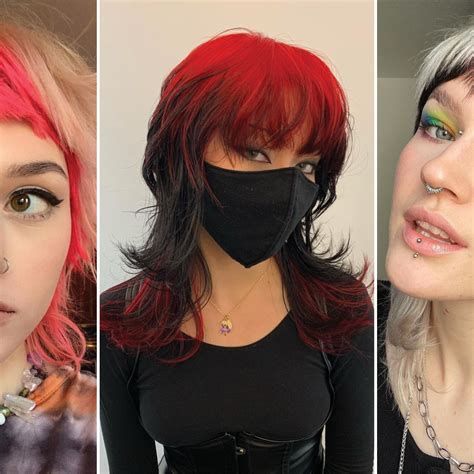Introduction: Clash of the Legends
The wolf cut and mullet, two iconic hairstyles that have made their mark on hairdressing history, are back with a vengeance. While both cuts share some similarities, they also have distinct differences that set them apart. In this comprehensive guide, we will delve into the intriguing world of wolf cuts and mullets, exploring their origins, variations, and the pros and cons of each.

Chapter 1: Genesis of Styles
1.1 Wolf Cut: A Breezy Revolution
Originating in the 1970s, the wolf cut gained popularity in the 1980s thanks to rock stars such as Joan Jett and Pat Benatar. This versatile haircut features choppy layers throughout the head, creating a wild and untamed look.
1.2 Mullet: A Controversial Legacy
The mullet, on the other hand, has a more unconventional history. It emerged in the 1970s and gained widespread popularity in the 1980s, particularly among rockers and rednecks. This distinctive haircut is characterized by short hair on top and sides, transitioning to long hair in the back.
Chapter 2: Variations and Styles
2.1 Wolf Cut Variants:
- Classic Wolf Cut: Layered throughout with choppy ends, creating a voluminous and textured look.
- Shaggy Wolf Cut: Longer layers with more volume, giving a bohemian and effortless vibe.
- Modern Wolf Cut: Blunted ends with less choppiness, offering a more refined and contemporary take.
2.2 Mullet Variations:
- Classic Mullet: Short on top and long in the back, with a distinct separation between lengths.
- Business Mullet: Similar to the classic mullet but with shorter back hair, suitable for professional settings.
- Modern Mullet: Blends longer hair on the sides and back with shorter top hair, creating a more stylish and polished look.
Chapter 3: Pros and Cons
3.1 Wolf Cut:
Pros:
– Adds volume and texture to fine hair.
– Suits various face shapes and ages.
– Easy to style and maintain.
Cons:
– Can appear messy if not cut correctly.
– May require frequent trims to maintain shape.
3.2 Mullet:
Pros:
– Distinctive and eye-catching.
– Can be styled in multiple ways.
– Ideal for those who want to grow out their hair.
Cons:
– Can be difficult to style and maintain.
– May not be suitable for all face shapes or professional settings.
– Often associated with dated or unflattering looks.
Chapter 4: Which Cut Is Right for You?
4.1 Factors to Consider:
- Face Shape: Wolf cuts suit round, oval, and square faces. Mullets can flatter long, oval, or triangular faces.
- Hair Texture: Wolf cuts work well for fine or medium hair, while mullets can accommodate thicker hair textures.
- Lifestyle: Wolf cuts are more versatile and suitable for various occasions. Mullets may require more effort to style and maintain.
- Personal Style: Ultimately, the choice between a wolf cut and mullet depends on one’s personal style and preferences.
Chapter 5: Tips and Tricks
5.1 Wolf Cut:
- Use dry shampoo to add volume.
- Blow-dry upside down for maximum lift.
- Experiment with different styling products to achieve desired texture.
5.2 Mullet:
- Brush the back hair regularly to avoid tangles.
- Use hairspray to hold the shape and keep flyaways at bay.
- Add layers to the front hair to create a more modern and flattering look.
Conclusion: The Cutting-Edge Showdown
Both wolf cuts and mullets offer unique and distinctive ways to express one’s individuality. Whether your style is effortlessly cool or boldly unconventional, there is a cut that will complement your personality. Ultimately, the best hairstyle is the one that makes you feel confident and fabulous. So, embrace your inner wolf or mullet and rock the haircut that suits you best.
